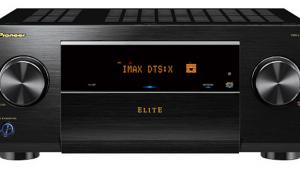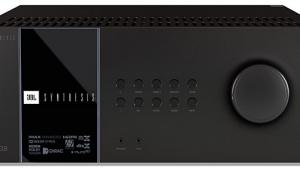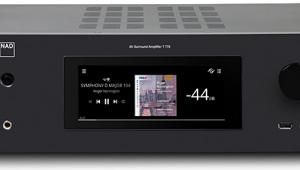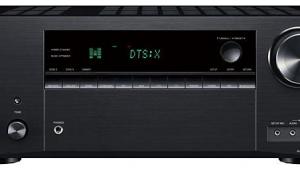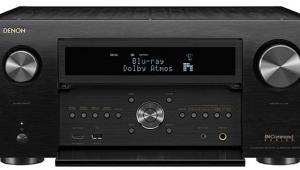Denon AVR-X1200W A/V Receiver Review Page 2
From the Bottom UP
Like its predecessor the AVR-S900W, the AVR-X1200W starts with an amp that’s a treat to listen to on its own, with a clean and well-behaved top end and surprisingly good bass for this price point. Adding Audyssey MultEQ XT room correction usually offered subtle imaging improvements while tampering relatively little with the tonal balance; perhaps Audyssey’s algorithm agrees with me that these receivers are listenable to begin with. As I’ve done in the past, I used Audyssey’s Reference mode (with a slight cinema EQ rolloff) for movies and the livelier Flat mode for music.
 Night at the Museum: Secret of
the Tomb gave the receiver a chance to demonstrate its virtues while stepping out of the way—“no personality,” I told my notebook approvingly. Timbral neutrality didn’t get in the way of dialogue clarity, surround envelopment, and overall listenability as Ben Stiller was propelled through a maelstrom of aggressive effects that complemented the onscreen CGI magic.
I did wonder if the thunder of triceratops feet might have been overdone. But the receiver’s ability
to juggle complex effects while maintaining its dynamic cool was impressive for the price.
Night at the Museum: Secret of
the Tomb gave the receiver a chance to demonstrate its virtues while stepping out of the way—“no personality,” I told my notebook approvingly. Timbral neutrality didn’t get in the way of dialogue clarity, surround envelopment, and overall listenability as Ben Stiller was propelled through a maelstrom of aggressive effects that complemented the onscreen CGI magic.
I did wonder if the thunder of triceratops feet might have been overdone. But the receiver’s ability
to juggle complex effects while maintaining its dynamic cool was impressive for the price.
The Equalizer pits Denzel Washington against Russian mob thugs in a dynamically potent soundtrack. With Denzel’s voice localizing in the sub, this time I was sure the bass was out of whack. Eventually, I identified the cause. It wasn’t Audyssey’s EQ per se; it was Audyssey’s recommendation to set the sub level at 50 percent before measurement. This didn’t give the room correction program enough leeway to set the right overall sub level during setup before equalization. A minor twist of the sub’s volume knob offered a temporary fix. (The permanent fix was to adjust the sub and rerun Audyssey for the next demo.) Once this distraction was eliminated, I got a charge out of how aggressively the soundtrack built up its echoing, bassy swirls of amorphous, ominous, all-channel music and psychologically subjective effects, which somehow enlarged and built upon the actor’s intensity and depth. It was meant to sound huge, and the receiver delivered.
I switched to the Pioneer speakers for the Atmos demo of Teenage Mutant Ninja Turtles. Running Audyssey MultEQ XT a second time, I dropped the initial sub volume from 50 to 33 percent, which allowed the program enough leeway to dole out bass in the right proportion. The receiver also allowed plenty of leeway in setting front height levels, and I took full advantage with a whopping 10-decibel boost. While unsubtle, this did make the ceiling effects pop, including the shattering strip light in the subway battle, voices lurking overhead on a fire escape, and the score’s numerous choral incantations, which added to its improbable majesty. I moved on to the Dolby Atmos Demonstration Disc, playing parts of it at unprecedented volumes that would make any $600 receiver clip. The Denon chugged along gracefully with seven very active channels, betraying little sign of trauma, perhaps aided by the subtle rolloff in the MultEQ XT Reference setting. The disc’s bass effects were especially well shaped.
Double Helix in the Sky Tonight
I can’t afford the now legendary Cisco pressing of Steely Dan’s Aja—but the Japanese single-
layer SACD has turned out to be an excellent investment. Denon’s treatment of this best-case demo material was a home run; I couldn’t find any way to pick it apart. The grooves were solid and satisfying, and Audyssey’s now-tweaked sub response kept even the fattest bass lines (“Black Cow”) under firm control. Lead and backing vocals were lush and almost shockingly colorful. When the Dan mustered their full arsenal of guitars, keys, vibes, saxes, and vocals in the overachieving title track—not to mention Steve Gadd’s explosive drum solo—the receiver coped with the simultaneous demands of dynamics and layering. All of this applied in both the room-corrected Audyssey Flat mode and the uncorrected direct and pure direct modes. (Pure direct attempts to improve on plain direct by shutting down the front-panel display and analog video circuit, though I didn’t hear a difference.)

Following a recent train of thought, I picked Tchaikovsky’s Symphony No. 4 off the LP shelves. This was a Deutsche Grammophon pressing of Claudio Abbado leading the Vienna Philharmonic in 1975, the late period of analog’s golden era, and therefore about as good as demo material gets. The receiver fearlessly resolved the peerless soaring strings with no sugarcoating or fatigue. The direct mode was marginally warmer, while the MultEQ XT mode was marginally better focused, though both were engrossingly listenable. The lively pizzicato of the Scherzo got the rhythmic momentum and definition it deserved, especially in the lower strings.
The closest I got to a gotcha! moment was the Audyssey treatment of Sgt. Pepper’s Lonely Hearts Club Band from the vinyl box set of The Beatles in Mono. What should have been a solid mono image was slightly spread out, as though certain frequencies were being pulled to the sides. The image snapped into tight monaural focus when I switched to direct mode. The unvarnished amp’s presentation was also denser, more rounded in a pleasing way, and greater in depth, which enhanced the separation of instruments occupying the same space. Perhaps Audyssey is optimized more for surround and stereo material than for mono.
The Denon AVR-X1200W is a great-sounding receiver with top-notch room correction—granting that there’s no such thing as perfect room correction if you push it far enough. Getting Audyssey takes the sting out of a few minor feature omissions (such as UHD upsampling and MHL). The $600 receiver in general remains one of the most extraordinary value propositions in consumer electronics, and this specimen is up there with the best.

